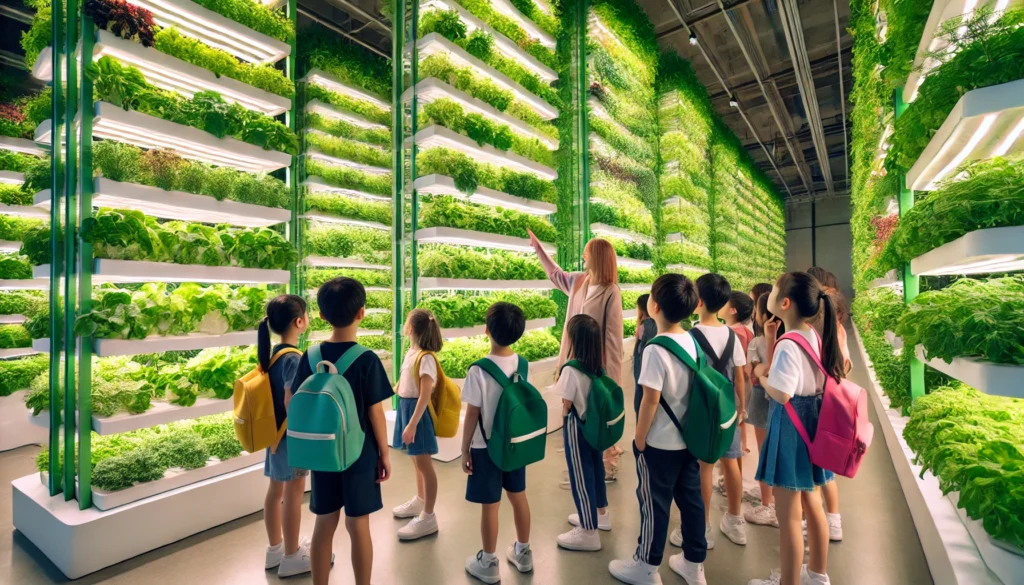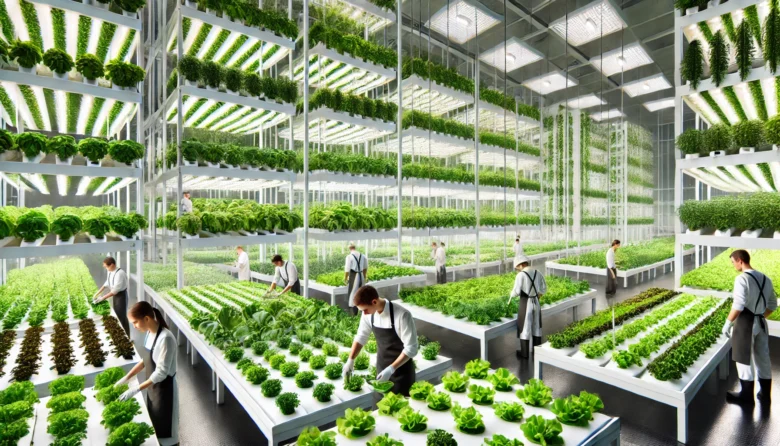Did you know that by 2050, two-thirds of the world’s population will live in cities? With urban spaces booming, we face a monumental challenge: How do we ensure sustainable food production to feed the growing populations in our urban centres? Vertical farming, a cutting-edge approach to agriculture, offers a promising solution by bringing farms into cities and growing crops in towering structures. This article explores how vertical farming can address the food supply challenges, reduce resource use, and transform our cities into food-secure, green spaces.
What is Vertical Farming?
In simple terms, vertical farming involves cultivating crops in stacked layers, often within controlled environments like high-rise buildings, warehouses, or shipping containers. Rather than sprawling across vast fields, crops in a vertical farm grow in “skyscraper” farms. These farms are often powered by advanced LED lighting and hydroponic or aeroponic systems, which allow plants to grow without soil. The aim? To use less land, water, and energy to produce high yields of fresh, nutritious food.
Why Cities Need Vertical Farms
With cities expanding rapidly, space for traditional agriculture is diminishing. At the same time, transporting food from rural farms to urban centres adds to greenhouse gas emissions, food wastage, and transportation costs. Vertical farming could be the ideal solution, addressing food security in an eco-friendly way. Here’s how:
Reducing Food Miles
One major benefit of vertical farming is its ability to reduce “food miles,” or the journey food takes from where it’s grown to where it’s consumed. Since vertical farms can be located within or near urban centres, they reduce the need for long-distance transportation. This not only lowers carbon emissions but also delivers fresher produce to consumers, as foods like lettuce, spinach, and strawberries are harvested and delivered within hours.

Conserving Water and Energy
Traditional farming is incredibly water-intensive. Vertical farms, however, use technologies like hydroponics (growing plants in water rather than soil) or aeroponics (using mist or air to deliver nutrients). These methods use up to 95% less water than traditional farming, making vertical farming a sustainable alternative in water-scarce regions. Additionally, LED lights and renewable energy sources help vertical farms become energy-efficient, ensuring minimal impact on the environment.
High Yields on Minimal Land
Vertical farms are designed to maximize crop yield per square foot. By stacking layers of crops and controlling the environment meticulously, farmers can grow multiple harvests year-round. This high-yield approach is essential for feeding growing urban populations. For example, New York City-based Bowery Farming has created indoor farms that produce 100 times more food per square foot than traditional farms.
Food Security and Resilience
With climate change posing a threat to traditional agriculture, vertical farms can provide a reliable alternative. Because these farms are indoors, they are shielded from extreme weather conditions, pests, and diseases. Vertical farms can grow a variety of crops all year, creating a buffer against food shortages due to weather disruptions or global supply chain issues.
Success Stories in Vertical Farming
Vertical farming is no longer just an experiment; it’s thriving in cities around the world. Let’s look at a few examples:
Aerofarms (Newark, New Jersey):
Aerofarms is a leader in vertical farming, utilizing aeroponics to grow leafy greens and herbs with 95% less water than traditional farming. The company supplies fresh produce to local grocery stores and restaurants, reducing the need for imported greens.
Sky Greens (Singapore):
In a land-scarce city-state, Sky Greens has established a unique, multi-tiered vertical farming system that grows crops like bok choy, lettuce, and spinach. By rotating each level in response to sunlight, this farm achieves consistent production while using minimal energy.
Plenty (San Francisco, California):
Plenty’s vertical farms are designed with robotics and artificial intelligence (AI) to ensure optimal plant growth. This technology helps monitor and adjust the environment, resulting in high yields and sustainable farming methods. The farm’s produce is sold at local supermarkets, demonstrating that vertical farming can be a viable business.
These examples illustrate that vertical farming is not just about growing food but also about building sustainable food networks.
Challenges and Future Potential of Vertical Farming
Despite its advantages, vertical farming still faces some hurdles:
High Initial Costs:
Setting up a vertical farm requires significant investment in infrastructure, technology, and energy. However, as technology advances and the demand for fresh, local food grows, these costs are expected to decrease.
Energy Consumption:
Although vertical farms save on water and land, they rely heavily on electricity, primarily for LED lighting. However, integrating renewable energy sources like solar and wind can mitigate this issue and make vertical farms more sustainable.
Limited Crop Variety:
Currently, vertical farms are best suited for leafy greens and herbs. Expanding to staple crops like grains or root vegetables requires further research and development.
That said, the potential of vertical farming to reshape urban food systems is undeniable. Research is ongoing, and the industry continues to innovate. With urban areas set to become home to billions more people, cities must invest in sustainable food production methods, and vertical farming provides a viable pathway.
The Path Forward: What Can You Do?
With vertical farming still growing, urban citizens can play a role in supporting this movement:
Buy Local and Fresh: Support local vertical farms by choosing their produce over imports. Look for farm-to-table grocery stores or online delivery services that source from vertical farms.
Advocate for Urban Agriculture: Encourage city governments to support vertical farming initiatives. Policies that encourage sustainable farming practices and offer support for startups can have a significant impact.
Grow Your Greens: Not everyone can start a vertical farm, but small indoor gardens can be a rewarding, sustainable way to grow food at home.
Conclusion
Vertical farming represents a revolutionary step in rethinking how we grow and access food in cities. With the ability to provide fresh, local produce with minimal environmental impact, vertical farming could be the key to feeding our urban future. As we face the twin challenges of population growth and climate change, supporting sustainable innovations like vertical farming can help us create resilient, food-secure cities.
Author’s Note
As someone deeply passionate about sustainable solutions, I believe vertical farming is more than just a trend—it’s a vital tool for building healthier, greener cities. Let’s embrace the future of farming together!
G.C., Ecosociosphere contributor.
References and Further Reading
- United Nations Report on Urban Population Growth
- World’s Most Unique and Innovative Farms – Cool Astro. https://www.coolastro.com/worlds-most-unique-and-innovative-farms/
- Growing with Baker Creek Seeds: My Garden Journey☑️. https://www.gossiperonline.com/growing-with-baker-creek-seeds-my-garden-journey/
- Vertical Farming Technology : Vertical Farming Market Size 2023 – 2032. https://www.sphericalinsights.com/blogs/vertical-farming-technology-everything-you-need-to-know-market-size-share-growth-demand-statistics-facts





Comments
Hello there, just became alert to your blog through Google, and found that it is really informative. I am going to watch out for brussels. I抣l be grateful if you continue this in future. Many people will be benefited from your writing. Cheers!
I have figured out some essential things through your website post. One other thing I would like to convey is that there are plenty of games available and which are designed particularly for toddler age little ones. They contain pattern identification, colors, dogs, and models. These generally focus on familiarization instead of memorization. This makes little kids occupied without having the experience like they are learning. Thanks
Attractive element of content. I simply stumbled upon your web site and in accession capital to claim that I acquire in fact loved account your weblog posts. Any way I will be subscribing to your augment or even I fulfillment you get right of entry to constantly fast.
Thank you for writing this post! http://www.hairstylesvip.com
Sustain the excellent work and producing in the group! http://www.hairstylesvip.com
You’ve been great to me. Thank you! http://www.hairstylesvip.com
Hey there would you mind letting me know which web host you’re utilizing?
I’ve loaded your blog in 3 different browsers and I must say this
blog loads a lot faster then most. Can you suggest a good internet
hosting provider at a fair price? Cheers, I appreciate it!
My web blog – nordvpn coupons inspiresensation (tinyurl.com)
You made some nice points there. I did a search on the subject matter and found most persons will approve with your website.